Changing Economics of Asia: An Analysis of Growth and Development
VerifiedAdded on 2021/04/24
|12
|3032
|176
Essay
AI Summary
This essay provides a comprehensive analysis of the changing economic landscape of Asia, focusing on the remarkable growth experienced by countries like China and Singapore over the past three decades. It begins by highlighting the rapid economic expansion of Asian nations compared to developed economies and then delves into the core concepts of endogenous growth theory, contrasting it with the neoclassical model. The essay explores the key characteristics of endogenous growth, including the significance of innovation, human capital, and governmental policies. It then examines the roles of government intervention, externalities, and the need for protectionist measures in fostering economic development. The essay uses Singapore and China as case studies, analyzing their growth trajectories and applying the principles of endogenous growth theory to explain their economic successes. The analysis includes data on GDP growth and discusses the strategic decisions that contributed to their economic advancements. The conclusion emphasizes the suitability of endogenous growth theory for promoting sustainable economic development in the Asian context.
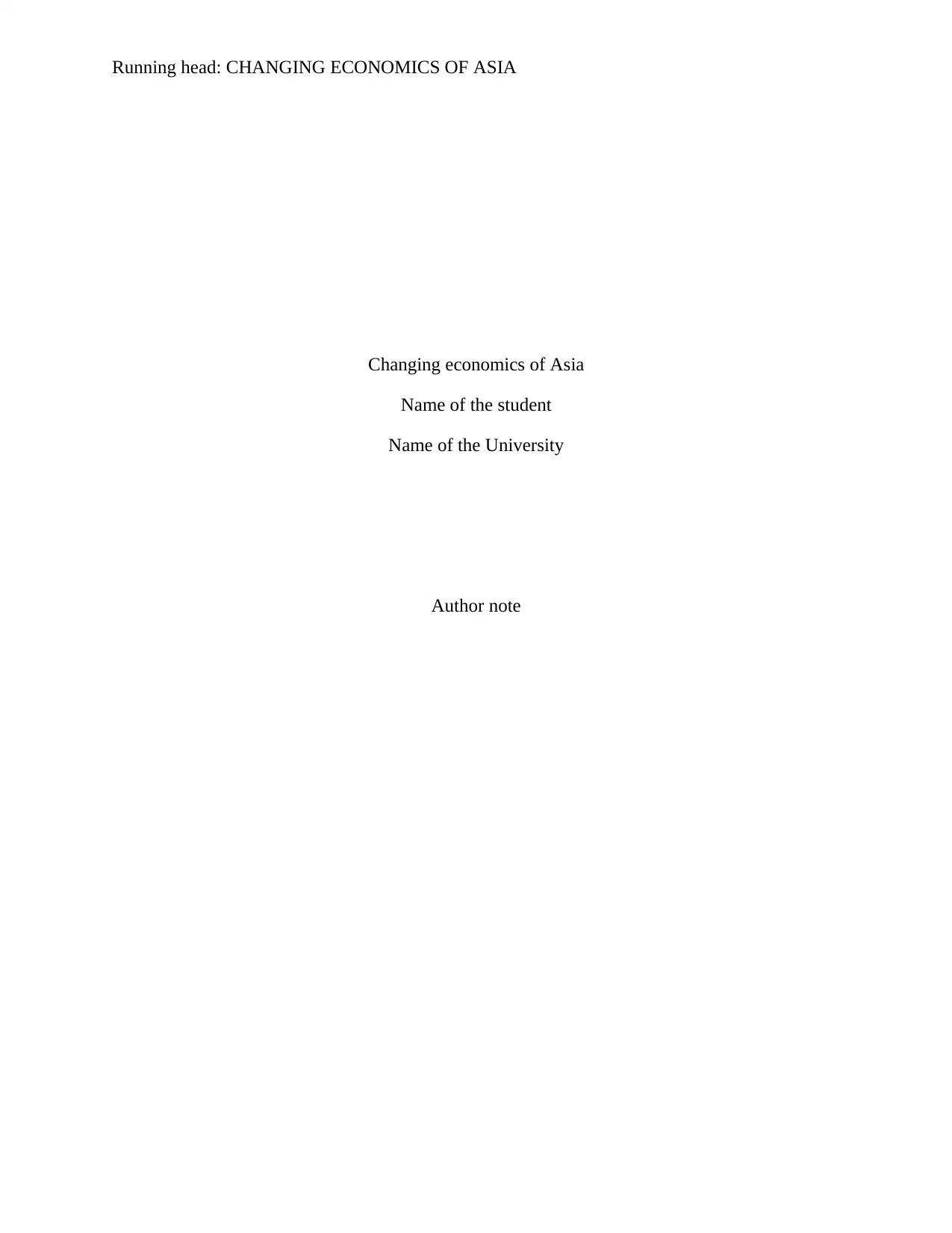
Running head: CHANGING ECONOMICS OF ASIA
Changing economics of Asia
Name of the student
Name of the University
Author note
Changing economics of Asia
Name of the student
Name of the University
Author note
Paraphrase This Document
Need a fresh take? Get an instant paraphrase of this document with our AI Paraphraser
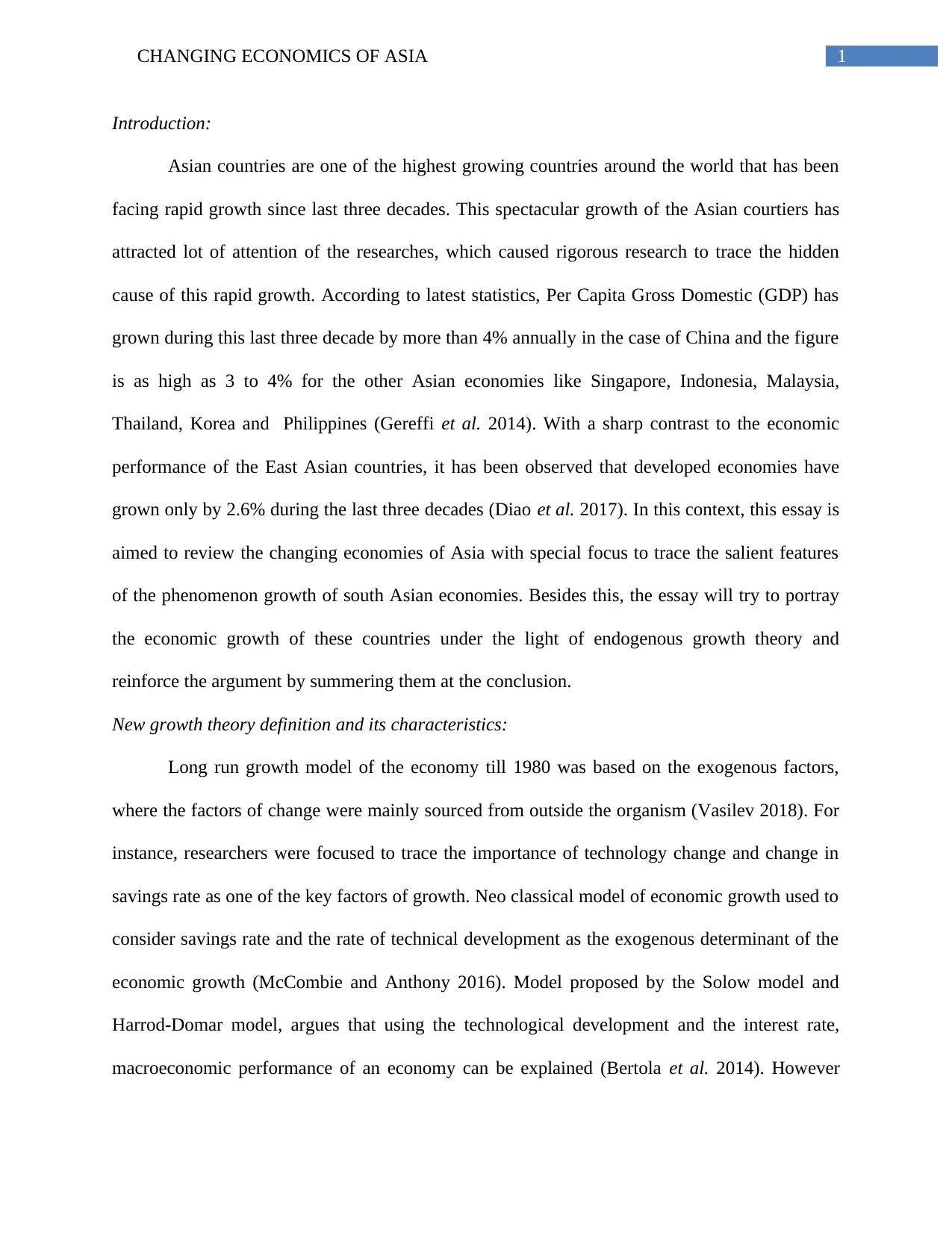
1CHANGING ECONOMICS OF ASIA
Introduction:
Asian countries are one of the highest growing countries around the world that has been
facing rapid growth since last three decades. This spectacular growth of the Asian courtiers has
attracted lot of attention of the researches, which caused rigorous research to trace the hidden
cause of this rapid growth. According to latest statistics, Per Capita Gross Domestic (GDP) has
grown during this last three decade by more than 4% annually in the case of China and the figure
is as high as 3 to 4% for the other Asian economies like Singapore, Indonesia, Malaysia,
Thailand, Korea and Philippines (Gereffi et al. 2014). With a sharp contrast to the economic
performance of the East Asian countries, it has been observed that developed economies have
grown only by 2.6% during the last three decades (Diao et al. 2017). In this context, this essay is
aimed to review the changing economies of Asia with special focus to trace the salient features
of the phenomenon growth of south Asian economies. Besides this, the essay will try to portray
the economic growth of these countries under the light of endogenous growth theory and
reinforce the argument by summering them at the conclusion.
New growth theory definition and its characteristics:
Long run growth model of the economy till 1980 was based on the exogenous factors,
where the factors of change were mainly sourced from outside the organism (Vasilev 2018). For
instance, researchers were focused to trace the importance of technology change and change in
savings rate as one of the key factors of growth. Neo classical model of economic growth used to
consider savings rate and the rate of technical development as the exogenous determinant of the
economic growth (McCombie and Anthony 2016). Model proposed by the Solow model and
Harrod-Domar model, argues that using the technological development and the interest rate,
macroeconomic performance of an economy can be explained (Bertola et al. 2014). However
Introduction:
Asian countries are one of the highest growing countries around the world that has been
facing rapid growth since last three decades. This spectacular growth of the Asian courtiers has
attracted lot of attention of the researches, which caused rigorous research to trace the hidden
cause of this rapid growth. According to latest statistics, Per Capita Gross Domestic (GDP) has
grown during this last three decade by more than 4% annually in the case of China and the figure
is as high as 3 to 4% for the other Asian economies like Singapore, Indonesia, Malaysia,
Thailand, Korea and Philippines (Gereffi et al. 2014). With a sharp contrast to the economic
performance of the East Asian countries, it has been observed that developed economies have
grown only by 2.6% during the last three decades (Diao et al. 2017). In this context, this essay is
aimed to review the changing economies of Asia with special focus to trace the salient features
of the phenomenon growth of south Asian economies. Besides this, the essay will try to portray
the economic growth of these countries under the light of endogenous growth theory and
reinforce the argument by summering them at the conclusion.
New growth theory definition and its characteristics:
Long run growth model of the economy till 1980 was based on the exogenous factors,
where the factors of change were mainly sourced from outside the organism (Vasilev 2018). For
instance, researchers were focused to trace the importance of technology change and change in
savings rate as one of the key factors of growth. Neo classical model of economic growth used to
consider savings rate and the rate of technical development as the exogenous determinant of the
economic growth (McCombie and Anthony 2016). Model proposed by the Solow model and
Harrod-Domar model, argues that using the technological development and the interest rate,
macroeconomic performance of an economy can be explained (Bertola et al. 2014). However
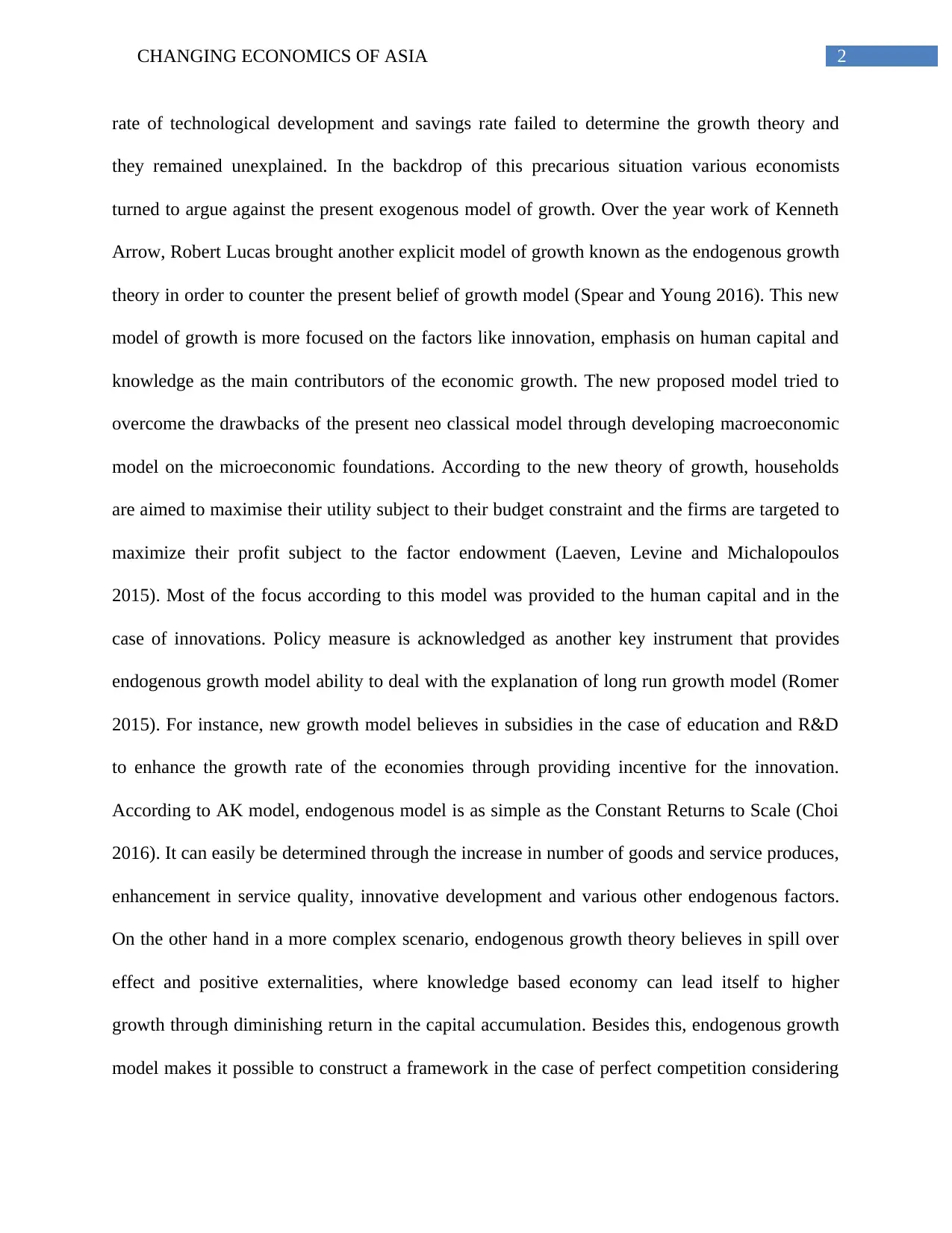
2CHANGING ECONOMICS OF ASIA
rate of technological development and savings rate failed to determine the growth theory and
they remained unexplained. In the backdrop of this precarious situation various economists
turned to argue against the present exogenous model of growth. Over the year work of Kenneth
Arrow, Robert Lucas brought another explicit model of growth known as the endogenous growth
theory in order to counter the present belief of growth model (Spear and Young 2016). This new
model of growth is more focused on the factors like innovation, emphasis on human capital and
knowledge as the main contributors of the economic growth. The new proposed model tried to
overcome the drawbacks of the present neo classical model through developing macroeconomic
model on the microeconomic foundations. According to the new theory of growth, households
are aimed to maximise their utility subject to their budget constraint and the firms are targeted to
maximize their profit subject to the factor endowment (Laeven, Levine and Michalopoulos
2015). Most of the focus according to this model was provided to the human capital and in the
case of innovations. Policy measure is acknowledged as another key instrument that provides
endogenous growth model ability to deal with the explanation of long run growth model (Romer
2015). For instance, new growth model believes in subsidies in the case of education and R&D
to enhance the growth rate of the economies through providing incentive for the innovation.
According to AK model, endogenous model is as simple as the Constant Returns to Scale (Choi
2016). It can easily be determined through the increase in number of goods and service produces,
enhancement in service quality, innovative development and various other endogenous factors.
On the other hand in a more complex scenario, endogenous growth theory believes in spill over
effect and positive externalities, where knowledge based economy can lead itself to higher
growth through diminishing return in the capital accumulation. Besides this, endogenous growth
model makes it possible to construct a framework in the case of perfect competition considering
rate of technological development and savings rate failed to determine the growth theory and
they remained unexplained. In the backdrop of this precarious situation various economists
turned to argue against the present exogenous model of growth. Over the year work of Kenneth
Arrow, Robert Lucas brought another explicit model of growth known as the endogenous growth
theory in order to counter the present belief of growth model (Spear and Young 2016). This new
model of growth is more focused on the factors like innovation, emphasis on human capital and
knowledge as the main contributors of the economic growth. The new proposed model tried to
overcome the drawbacks of the present neo classical model through developing macroeconomic
model on the microeconomic foundations. According to the new theory of growth, households
are aimed to maximise their utility subject to their budget constraint and the firms are targeted to
maximize their profit subject to the factor endowment (Laeven, Levine and Michalopoulos
2015). Most of the focus according to this model was provided to the human capital and in the
case of innovations. Policy measure is acknowledged as another key instrument that provides
endogenous growth model ability to deal with the explanation of long run growth model (Romer
2015). For instance, new growth model believes in subsidies in the case of education and R&D
to enhance the growth rate of the economies through providing incentive for the innovation.
According to AK model, endogenous model is as simple as the Constant Returns to Scale (Choi
2016). It can easily be determined through the increase in number of goods and service produces,
enhancement in service quality, innovative development and various other endogenous factors.
On the other hand in a more complex scenario, endogenous growth theory believes in spill over
effect and positive externalities, where knowledge based economy can lead itself to higher
growth through diminishing return in the capital accumulation. Besides this, endogenous growth
model makes it possible to construct a framework in the case of perfect competition considering
⊘ This is a preview!⊘
Do you want full access?
Subscribe today to unlock all pages.

Trusted by 1+ million students worldwide
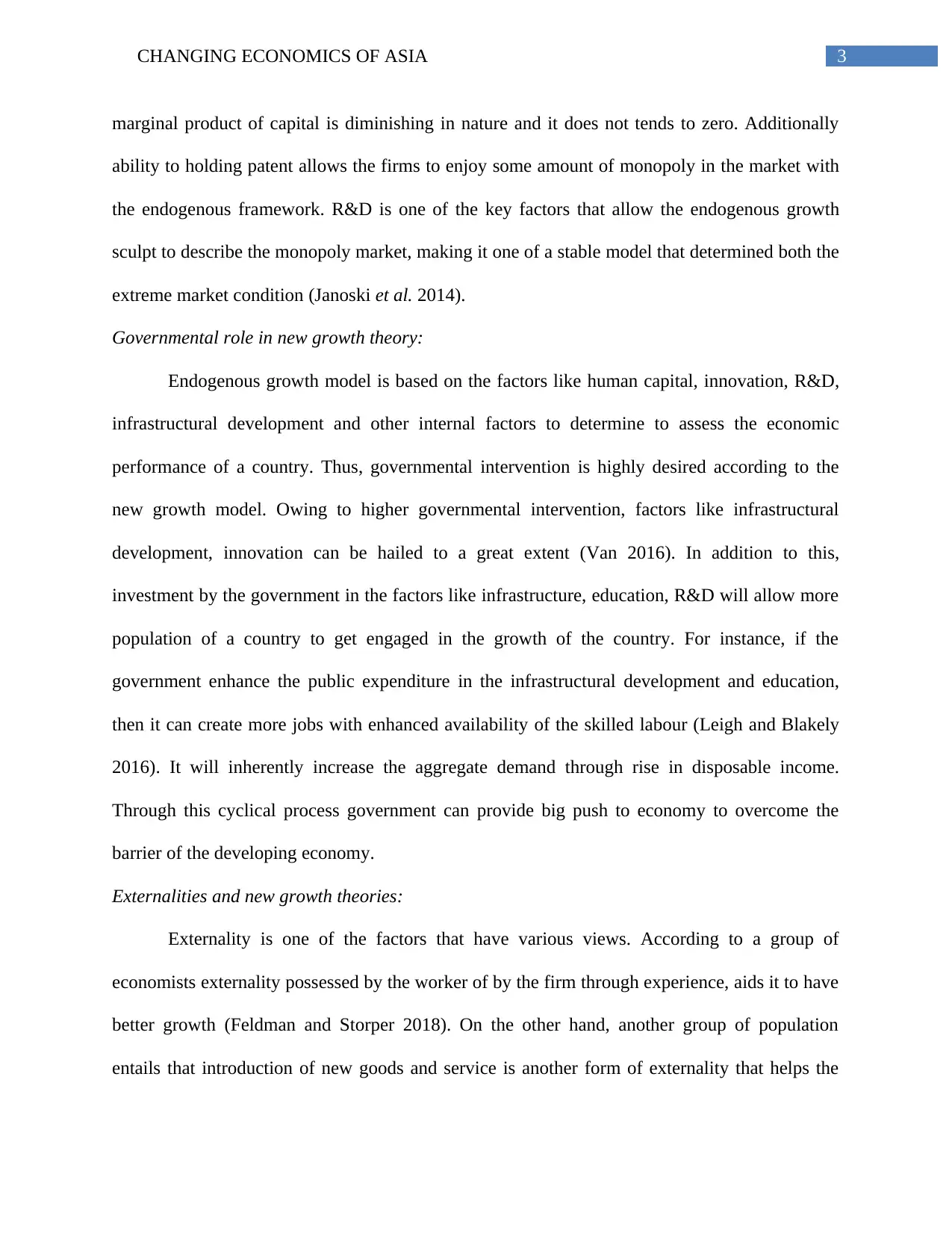
3CHANGING ECONOMICS OF ASIA
marginal product of capital is diminishing in nature and it does not tends to zero. Additionally
ability to holding patent allows the firms to enjoy some amount of monopoly in the market with
the endogenous framework. R&D is one of the key factors that allow the endogenous growth
sculpt to describe the monopoly market, making it one of a stable model that determined both the
extreme market condition (Janoski et al. 2014).
Governmental role in new growth theory:
Endogenous growth model is based on the factors like human capital, innovation, R&D,
infrastructural development and other internal factors to determine to assess the economic
performance of a country. Thus, governmental intervention is highly desired according to the
new growth model. Owing to higher governmental intervention, factors like infrastructural
development, innovation can be hailed to a great extent (Van 2016). In addition to this,
investment by the government in the factors like infrastructure, education, R&D will allow more
population of a country to get engaged in the growth of the country. For instance, if the
government enhance the public expenditure in the infrastructural development and education,
then it can create more jobs with enhanced availability of the skilled labour (Leigh and Blakely
2016). It will inherently increase the aggregate demand through rise in disposable income.
Through this cyclical process government can provide big push to economy to overcome the
barrier of the developing economy.
Externalities and new growth theories:
Externality is one of the factors that have various views. According to a group of
economists externality possessed by the worker of by the firm through experience, aids it to have
better growth (Feldman and Storper 2018). On the other hand, another group of population
entails that introduction of new goods and service is another form of externality that helps the
marginal product of capital is diminishing in nature and it does not tends to zero. Additionally
ability to holding patent allows the firms to enjoy some amount of monopoly in the market with
the endogenous framework. R&D is one of the key factors that allow the endogenous growth
sculpt to describe the monopoly market, making it one of a stable model that determined both the
extreme market condition (Janoski et al. 2014).
Governmental role in new growth theory:
Endogenous growth model is based on the factors like human capital, innovation, R&D,
infrastructural development and other internal factors to determine to assess the economic
performance of a country. Thus, governmental intervention is highly desired according to the
new growth model. Owing to higher governmental intervention, factors like infrastructural
development, innovation can be hailed to a great extent (Van 2016). In addition to this,
investment by the government in the factors like infrastructure, education, R&D will allow more
population of a country to get engaged in the growth of the country. For instance, if the
government enhance the public expenditure in the infrastructural development and education,
then it can create more jobs with enhanced availability of the skilled labour (Leigh and Blakely
2016). It will inherently increase the aggregate demand through rise in disposable income.
Through this cyclical process government can provide big push to economy to overcome the
barrier of the developing economy.
Externalities and new growth theories:
Externality is one of the factors that have various views. According to a group of
economists externality possessed by the worker of by the firm through experience, aids it to have
better growth (Feldman and Storper 2018). On the other hand, another group of population
entails that introduction of new goods and service is another form of externality that helps the
Paraphrase This Document
Need a fresh take? Get an instant paraphrase of this document with our AI Paraphraser
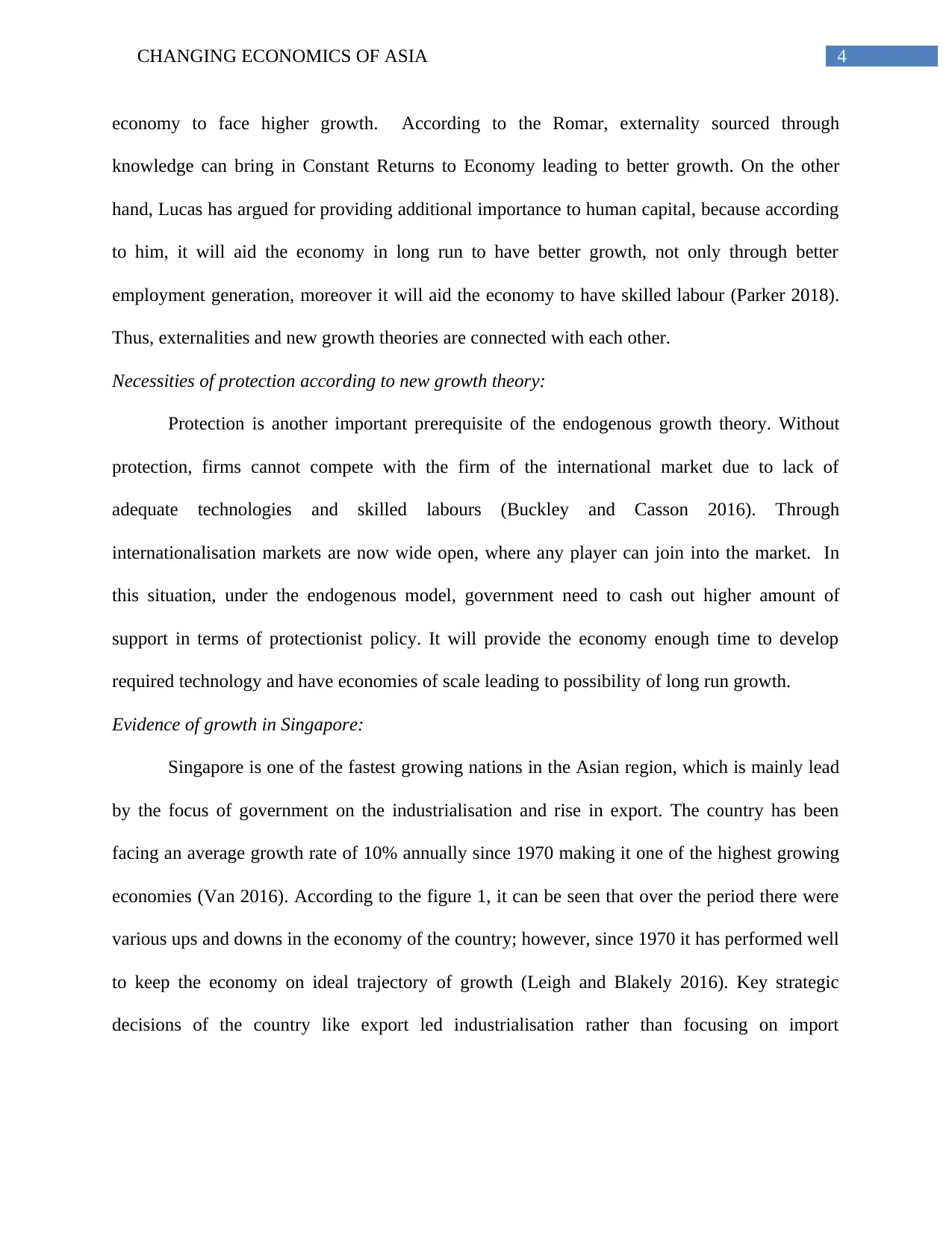
4CHANGING ECONOMICS OF ASIA
economy to face higher growth. According to the Romar, externality sourced through
knowledge can bring in Constant Returns to Economy leading to better growth. On the other
hand, Lucas has argued for providing additional importance to human capital, because according
to him, it will aid the economy in long run to have better growth, not only through better
employment generation, moreover it will aid the economy to have skilled labour (Parker 2018).
Thus, externalities and new growth theories are connected with each other.
Necessities of protection according to new growth theory:
Protection is another important prerequisite of the endogenous growth theory. Without
protection, firms cannot compete with the firm of the international market due to lack of
adequate technologies and skilled labours (Buckley and Casson 2016). Through
internationalisation markets are now wide open, where any player can join into the market. In
this situation, under the endogenous model, government need to cash out higher amount of
support in terms of protectionist policy. It will provide the economy enough time to develop
required technology and have economies of scale leading to possibility of long run growth.
Evidence of growth in Singapore:
Singapore is one of the fastest growing nations in the Asian region, which is mainly lead
by the focus of government on the industrialisation and rise in export. The country has been
facing an average growth rate of 10% annually since 1970 making it one of the highest growing
economies (Van 2016). According to the figure 1, it can be seen that over the period there were
various ups and downs in the economy of the country; however, since 1970 it has performed well
to keep the economy on ideal trajectory of growth (Leigh and Blakely 2016). Key strategic
decisions of the country like export led industrialisation rather than focusing on import
economy to face higher growth. According to the Romar, externality sourced through
knowledge can bring in Constant Returns to Economy leading to better growth. On the other
hand, Lucas has argued for providing additional importance to human capital, because according
to him, it will aid the economy in long run to have better growth, not only through better
employment generation, moreover it will aid the economy to have skilled labour (Parker 2018).
Thus, externalities and new growth theories are connected with each other.
Necessities of protection according to new growth theory:
Protection is another important prerequisite of the endogenous growth theory. Without
protection, firms cannot compete with the firm of the international market due to lack of
adequate technologies and skilled labours (Buckley and Casson 2016). Through
internationalisation markets are now wide open, where any player can join into the market. In
this situation, under the endogenous model, government need to cash out higher amount of
support in terms of protectionist policy. It will provide the economy enough time to develop
required technology and have economies of scale leading to possibility of long run growth.
Evidence of growth in Singapore:
Singapore is one of the fastest growing nations in the Asian region, which is mainly lead
by the focus of government on the industrialisation and rise in export. The country has been
facing an average growth rate of 10% annually since 1970 making it one of the highest growing
economies (Van 2016). According to the figure 1, it can be seen that over the period there were
various ups and downs in the economy of the country; however, since 1970 it has performed well
to keep the economy on ideal trajectory of growth (Leigh and Blakely 2016). Key strategic
decisions of the country like export led industrialisation rather than focusing on import
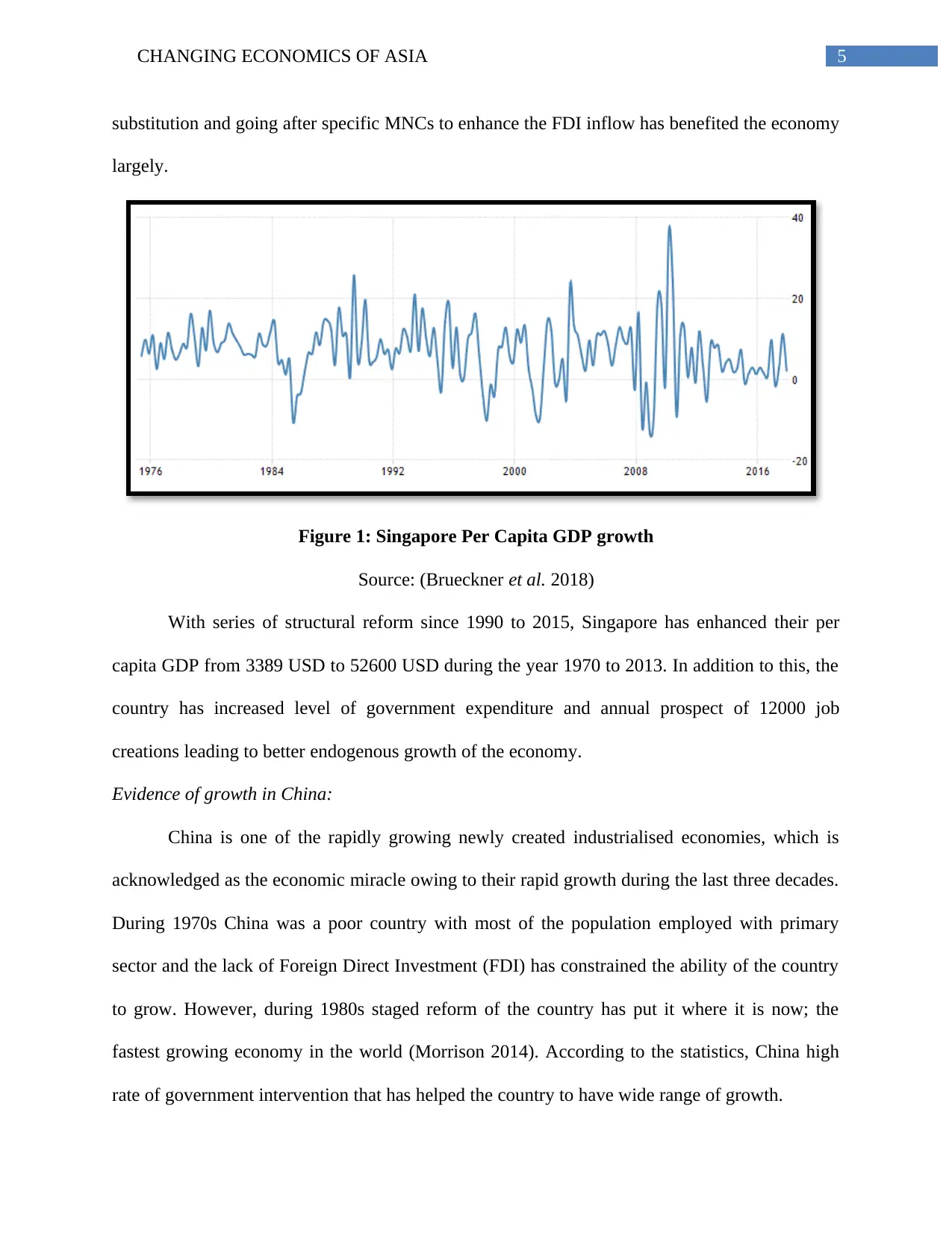
5CHANGING ECONOMICS OF ASIA
substitution and going after specific MNCs to enhance the FDI inflow has benefited the economy
largely.
Figure 1: Singapore Per Capita GDP growth
Source: (Brueckner et al. 2018)
With series of structural reform since 1990 to 2015, Singapore has enhanced their per
capita GDP from 3389 USD to 52600 USD during the year 1970 to 2013. In addition to this, the
country has increased level of government expenditure and annual prospect of 12000 job
creations leading to better endogenous growth of the economy.
Evidence of growth in China:
China is one of the rapidly growing newly created industrialised economies, which is
acknowledged as the economic miracle owing to their rapid growth during the last three decades.
During 1970s China was a poor country with most of the population employed with primary
sector and the lack of Foreign Direct Investment (FDI) has constrained the ability of the country
to grow. However, during 1980s staged reform of the country has put it where it is now; the
fastest growing economy in the world (Morrison 2014). According to the statistics, China high
rate of government intervention that has helped the country to have wide range of growth.
substitution and going after specific MNCs to enhance the FDI inflow has benefited the economy
largely.
Figure 1: Singapore Per Capita GDP growth
Source: (Brueckner et al. 2018)
With series of structural reform since 1990 to 2015, Singapore has enhanced their per
capita GDP from 3389 USD to 52600 USD during the year 1970 to 2013. In addition to this, the
country has increased level of government expenditure and annual prospect of 12000 job
creations leading to better endogenous growth of the economy.
Evidence of growth in China:
China is one of the rapidly growing newly created industrialised economies, which is
acknowledged as the economic miracle owing to their rapid growth during the last three decades.
During 1970s China was a poor country with most of the population employed with primary
sector and the lack of Foreign Direct Investment (FDI) has constrained the ability of the country
to grow. However, during 1980s staged reform of the country has put it where it is now; the
fastest growing economy in the world (Morrison 2014). According to the statistics, China high
rate of government intervention that has helped the country to have wide range of growth.
⊘ This is a preview!⊘
Do you want full access?
Subscribe today to unlock all pages.

Trusted by 1+ million students worldwide
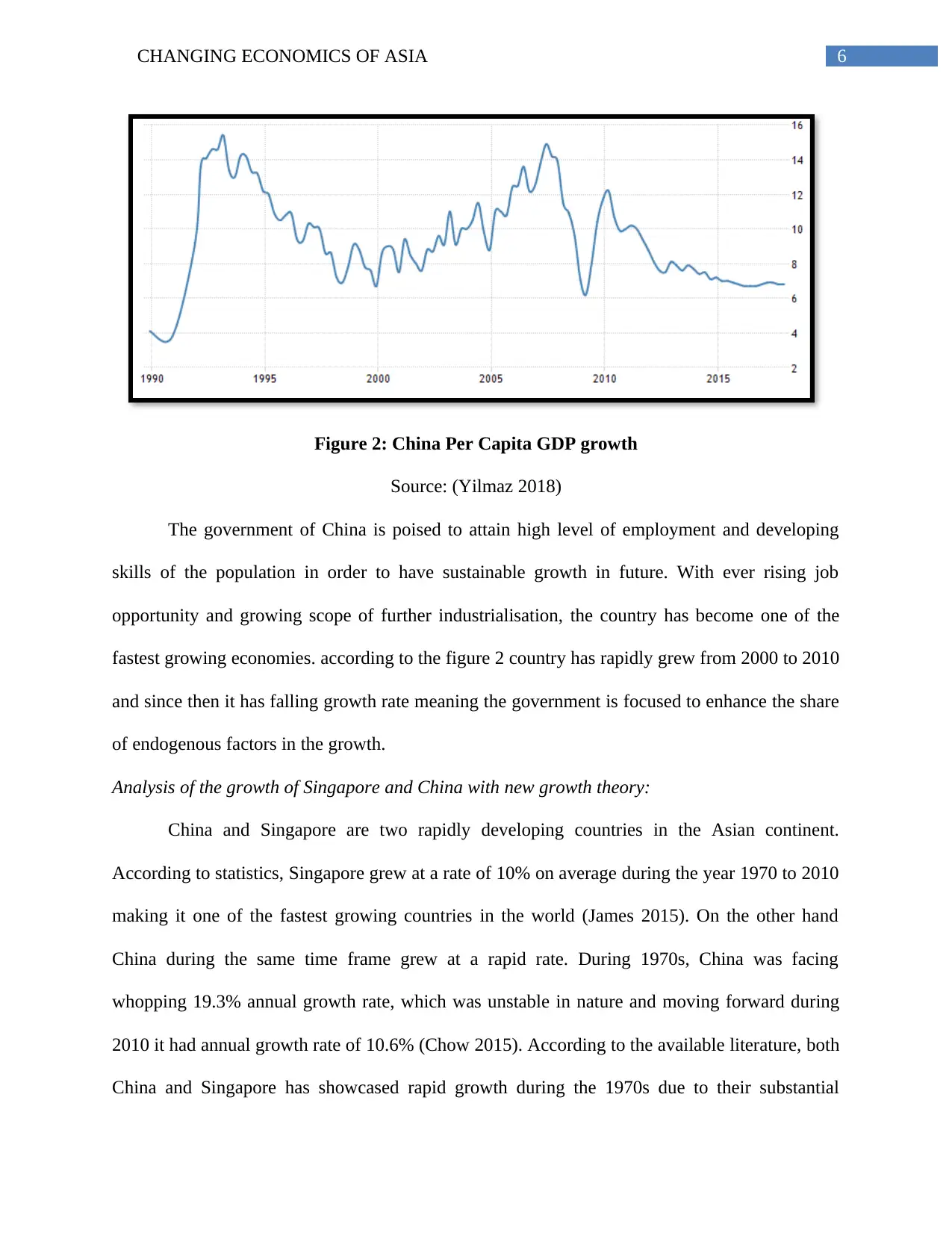
6CHANGING ECONOMICS OF ASIA
Figure 2: China Per Capita GDP growth
Source: (Yilmaz 2018)
The government of China is poised to attain high level of employment and developing
skills of the population in order to have sustainable growth in future. With ever rising job
opportunity and growing scope of further industrialisation, the country has become one of the
fastest growing economies. according to the figure 2 country has rapidly grew from 2000 to 2010
and since then it has falling growth rate meaning the government is focused to enhance the share
of endogenous factors in the growth.
Analysis of the growth of Singapore and China with new growth theory:
China and Singapore are two rapidly developing countries in the Asian continent.
According to statistics, Singapore grew at a rate of 10% on average during the year 1970 to 2010
making it one of the fastest growing countries in the world (James 2015). On the other hand
China during the same time frame grew at a rapid rate. During 1970s, China was facing
whopping 19.3% annual growth rate, which was unstable in nature and moving forward during
2010 it had annual growth rate of 10.6% (Chow 2015). According to the available literature, both
China and Singapore has showcased rapid growth during the 1970s due to their substantial
Figure 2: China Per Capita GDP growth
Source: (Yilmaz 2018)
The government of China is poised to attain high level of employment and developing
skills of the population in order to have sustainable growth in future. With ever rising job
opportunity and growing scope of further industrialisation, the country has become one of the
fastest growing economies. according to the figure 2 country has rapidly grew from 2000 to 2010
and since then it has falling growth rate meaning the government is focused to enhance the share
of endogenous factors in the growth.
Analysis of the growth of Singapore and China with new growth theory:
China and Singapore are two rapidly developing countries in the Asian continent.
According to statistics, Singapore grew at a rate of 10% on average during the year 1970 to 2010
making it one of the fastest growing countries in the world (James 2015). On the other hand
China during the same time frame grew at a rapid rate. During 1970s, China was facing
whopping 19.3% annual growth rate, which was unstable in nature and moving forward during
2010 it had annual growth rate of 10.6% (Chow 2015). According to the available literature, both
China and Singapore has showcased rapid growth during the 1970s due to their substantial
Paraphrase This Document
Need a fresh take? Get an instant paraphrase of this document with our AI Paraphraser
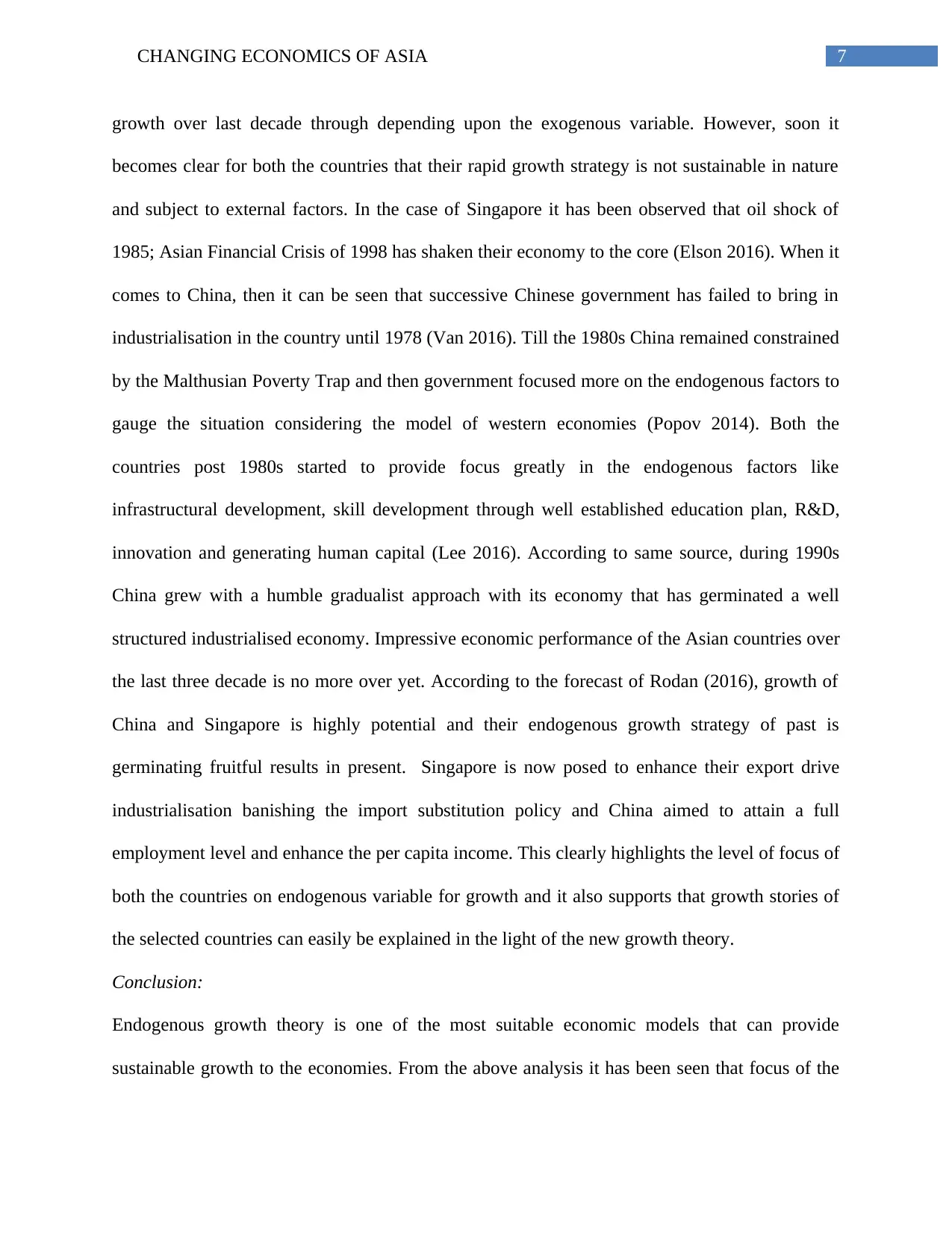
7CHANGING ECONOMICS OF ASIA
growth over last decade through depending upon the exogenous variable. However, soon it
becomes clear for both the countries that their rapid growth strategy is not sustainable in nature
and subject to external factors. In the case of Singapore it has been observed that oil shock of
1985; Asian Financial Crisis of 1998 has shaken their economy to the core (Elson 2016). When it
comes to China, then it can be seen that successive Chinese government has failed to bring in
industrialisation in the country until 1978 (Van 2016). Till the 1980s China remained constrained
by the Malthusian Poverty Trap and then government focused more on the endogenous factors to
gauge the situation considering the model of western economies (Popov 2014). Both the
countries post 1980s started to provide focus greatly in the endogenous factors like
infrastructural development, skill development through well established education plan, R&D,
innovation and generating human capital (Lee 2016). According to same source, during 1990s
China grew with a humble gradualist approach with its economy that has germinated a well
structured industrialised economy. Impressive economic performance of the Asian countries over
the last three decade is no more over yet. According to the forecast of Rodan (2016), growth of
China and Singapore is highly potential and their endogenous growth strategy of past is
germinating fruitful results in present. Singapore is now posed to enhance their export drive
industrialisation banishing the import substitution policy and China aimed to attain a full
employment level and enhance the per capita income. This clearly highlights the level of focus of
both the countries on endogenous variable for growth and it also supports that growth stories of
the selected countries can easily be explained in the light of the new growth theory.
Conclusion:
Endogenous growth theory is one of the most suitable economic models that can provide
sustainable growth to the economies. From the above analysis it has been seen that focus of the
growth over last decade through depending upon the exogenous variable. However, soon it
becomes clear for both the countries that their rapid growth strategy is not sustainable in nature
and subject to external factors. In the case of Singapore it has been observed that oil shock of
1985; Asian Financial Crisis of 1998 has shaken their economy to the core (Elson 2016). When it
comes to China, then it can be seen that successive Chinese government has failed to bring in
industrialisation in the country until 1978 (Van 2016). Till the 1980s China remained constrained
by the Malthusian Poverty Trap and then government focused more on the endogenous factors to
gauge the situation considering the model of western economies (Popov 2014). Both the
countries post 1980s started to provide focus greatly in the endogenous factors like
infrastructural development, skill development through well established education plan, R&D,
innovation and generating human capital (Lee 2016). According to same source, during 1990s
China grew with a humble gradualist approach with its economy that has germinated a well
structured industrialised economy. Impressive economic performance of the Asian countries over
the last three decade is no more over yet. According to the forecast of Rodan (2016), growth of
China and Singapore is highly potential and their endogenous growth strategy of past is
germinating fruitful results in present. Singapore is now posed to enhance their export drive
industrialisation banishing the import substitution policy and China aimed to attain a full
employment level and enhance the per capita income. This clearly highlights the level of focus of
both the countries on endogenous variable for growth and it also supports that growth stories of
the selected countries can easily be explained in the light of the new growth theory.
Conclusion:
Endogenous growth theory is one of the most suitable economic models that can provide
sustainable growth to the economies. From the above analysis it has been seen that focus of the
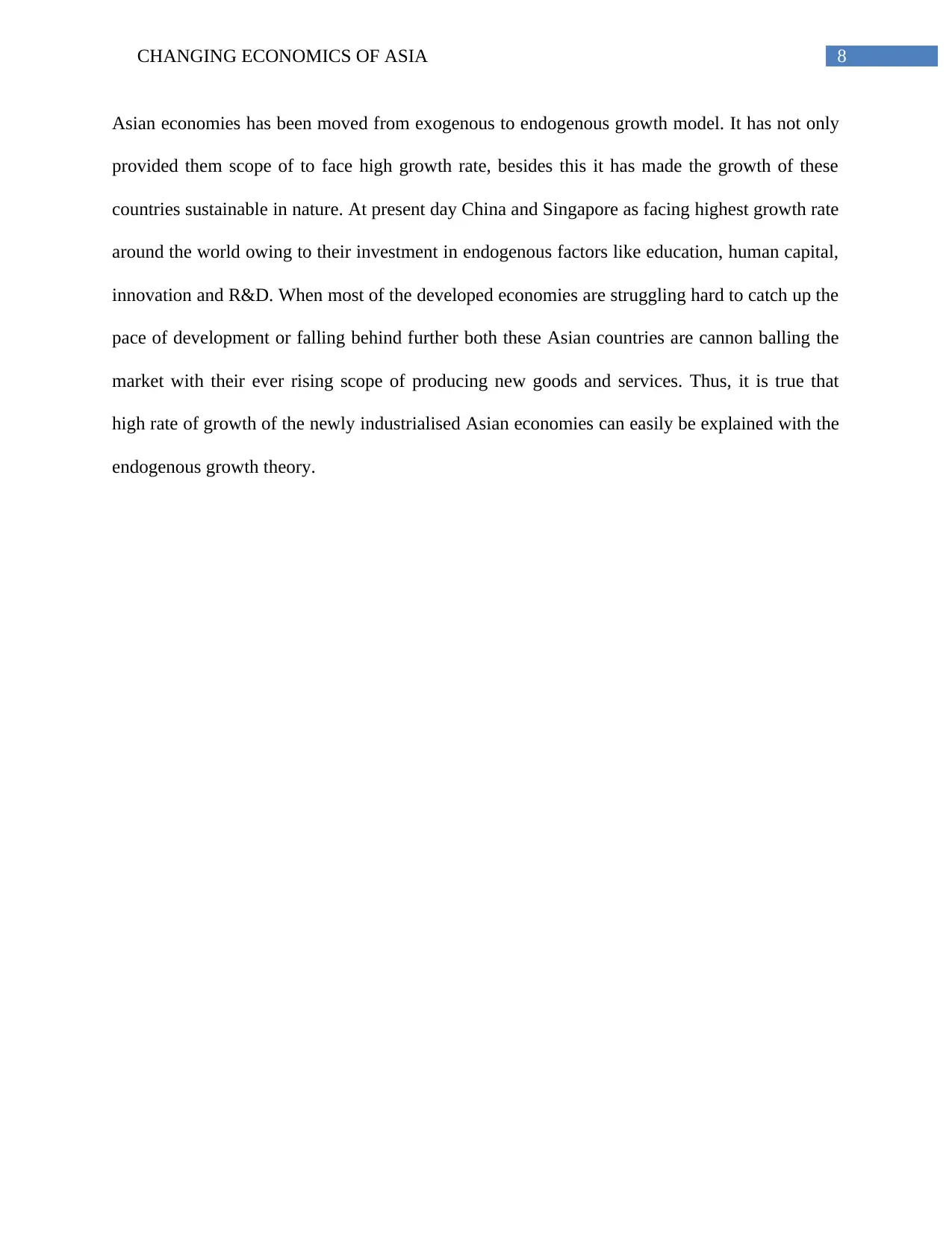
8CHANGING ECONOMICS OF ASIA
Asian economies has been moved from exogenous to endogenous growth model. It has not only
provided them scope of to face high growth rate, besides this it has made the growth of these
countries sustainable in nature. At present day China and Singapore as facing highest growth rate
around the world owing to their investment in endogenous factors like education, human capital,
innovation and R&D. When most of the developed economies are struggling hard to catch up the
pace of development or falling behind further both these Asian countries are cannon balling the
market with their ever rising scope of producing new goods and services. Thus, it is true that
high rate of growth of the newly industrialised Asian economies can easily be explained with the
endogenous growth theory.
Asian economies has been moved from exogenous to endogenous growth model. It has not only
provided them scope of to face high growth rate, besides this it has made the growth of these
countries sustainable in nature. At present day China and Singapore as facing highest growth rate
around the world owing to their investment in endogenous factors like education, human capital,
innovation and R&D. When most of the developed economies are struggling hard to catch up the
pace of development or falling behind further both these Asian countries are cannon balling the
market with their ever rising scope of producing new goods and services. Thus, it is true that
high rate of growth of the newly industrialised Asian economies can easily be explained with the
endogenous growth theory.
⊘ This is a preview!⊘
Do you want full access?
Subscribe today to unlock all pages.

Trusted by 1+ million students worldwide
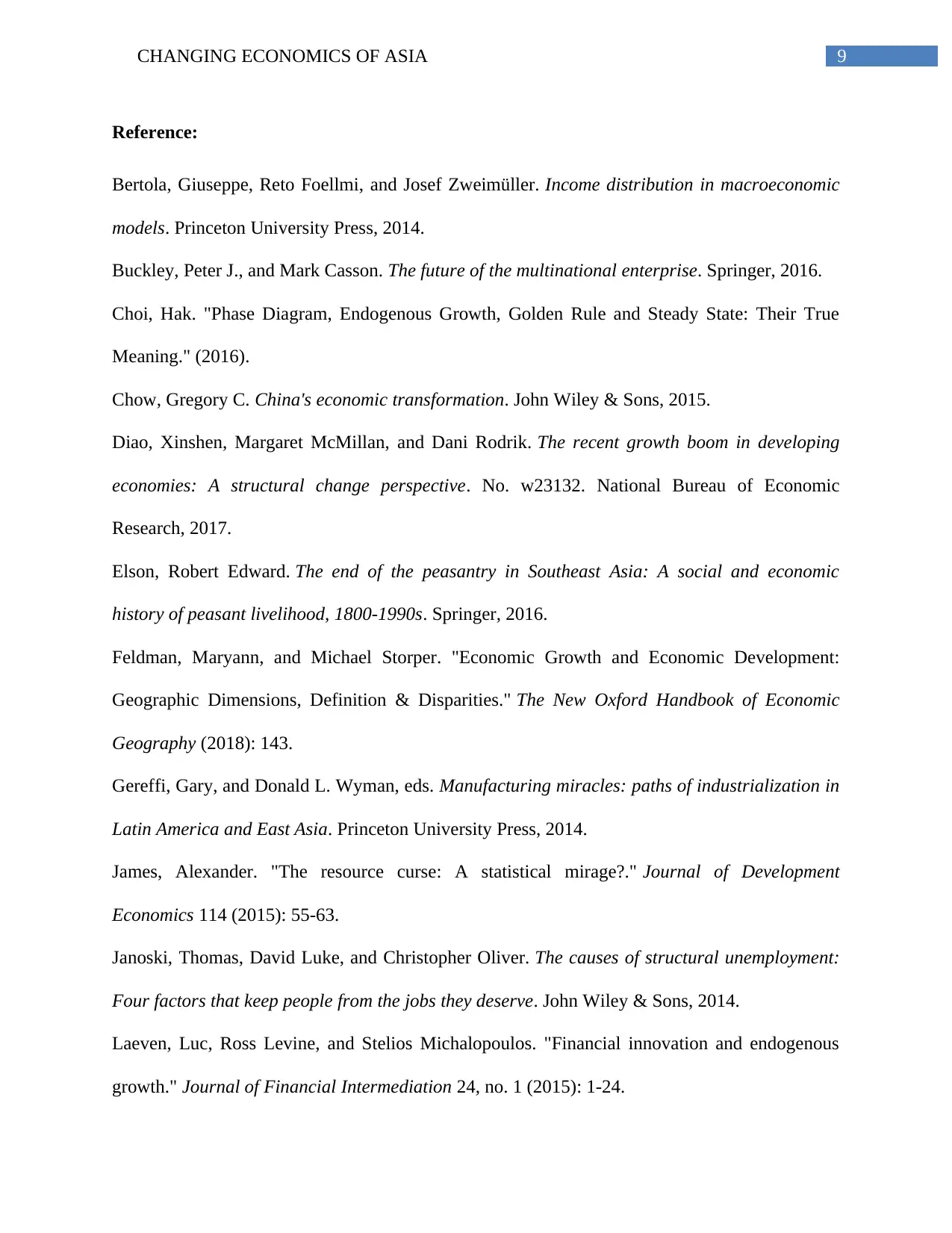
9CHANGING ECONOMICS OF ASIA
Reference:
Bertola, Giuseppe, Reto Foellmi, and Josef Zweimüller. Income distribution in macroeconomic
models. Princeton University Press, 2014.
Buckley, Peter J., and Mark Casson. The future of the multinational enterprise. Springer, 2016.
Choi, Hak. "Phase Diagram, Endogenous Growth, Golden Rule and Steady State: Their True
Meaning." (2016).
Chow, Gregory C. China's economic transformation. John Wiley & Sons, 2015.
Diao, Xinshen, Margaret McMillan, and Dani Rodrik. The recent growth boom in developing
economies: A structural change perspective. No. w23132. National Bureau of Economic
Research, 2017.
Elson, Robert Edward. The end of the peasantry in Southeast Asia: A social and economic
history of peasant livelihood, 1800-1990s. Springer, 2016.
Feldman, Maryann, and Michael Storper. "Economic Growth and Economic Development:
Geographic Dimensions, Definition & Disparities." The New Oxford Handbook of Economic
Geography (2018): 143.
Gereffi, Gary, and Donald L. Wyman, eds. Manufacturing miracles: paths of industrialization in
Latin America and East Asia. Princeton University Press, 2014.
James, Alexander. "The resource curse: A statistical mirage?." Journal of Development
Economics 114 (2015): 55-63.
Janoski, Thomas, David Luke, and Christopher Oliver. The causes of structural unemployment:
Four factors that keep people from the jobs they deserve. John Wiley & Sons, 2014.
Laeven, Luc, Ross Levine, and Stelios Michalopoulos. "Financial innovation and endogenous
growth." Journal of Financial Intermediation 24, no. 1 (2015): 1-24.
Reference:
Bertola, Giuseppe, Reto Foellmi, and Josef Zweimüller. Income distribution in macroeconomic
models. Princeton University Press, 2014.
Buckley, Peter J., and Mark Casson. The future of the multinational enterprise. Springer, 2016.
Choi, Hak. "Phase Diagram, Endogenous Growth, Golden Rule and Steady State: Their True
Meaning." (2016).
Chow, Gregory C. China's economic transformation. John Wiley & Sons, 2015.
Diao, Xinshen, Margaret McMillan, and Dani Rodrik. The recent growth boom in developing
economies: A structural change perspective. No. w23132. National Bureau of Economic
Research, 2017.
Elson, Robert Edward. The end of the peasantry in Southeast Asia: A social and economic
history of peasant livelihood, 1800-1990s. Springer, 2016.
Feldman, Maryann, and Michael Storper. "Economic Growth and Economic Development:
Geographic Dimensions, Definition & Disparities." The New Oxford Handbook of Economic
Geography (2018): 143.
Gereffi, Gary, and Donald L. Wyman, eds. Manufacturing miracles: paths of industrialization in
Latin America and East Asia. Princeton University Press, 2014.
James, Alexander. "The resource curse: A statistical mirage?." Journal of Development
Economics 114 (2015): 55-63.
Janoski, Thomas, David Luke, and Christopher Oliver. The causes of structural unemployment:
Four factors that keep people from the jobs they deserve. John Wiley & Sons, 2014.
Laeven, Luc, Ross Levine, and Stelios Michalopoulos. "Financial innovation and endogenous
growth." Journal of Financial Intermediation 24, no. 1 (2015): 1-24.
Paraphrase This Document
Need a fresh take? Get an instant paraphrase of this document with our AI Paraphraser
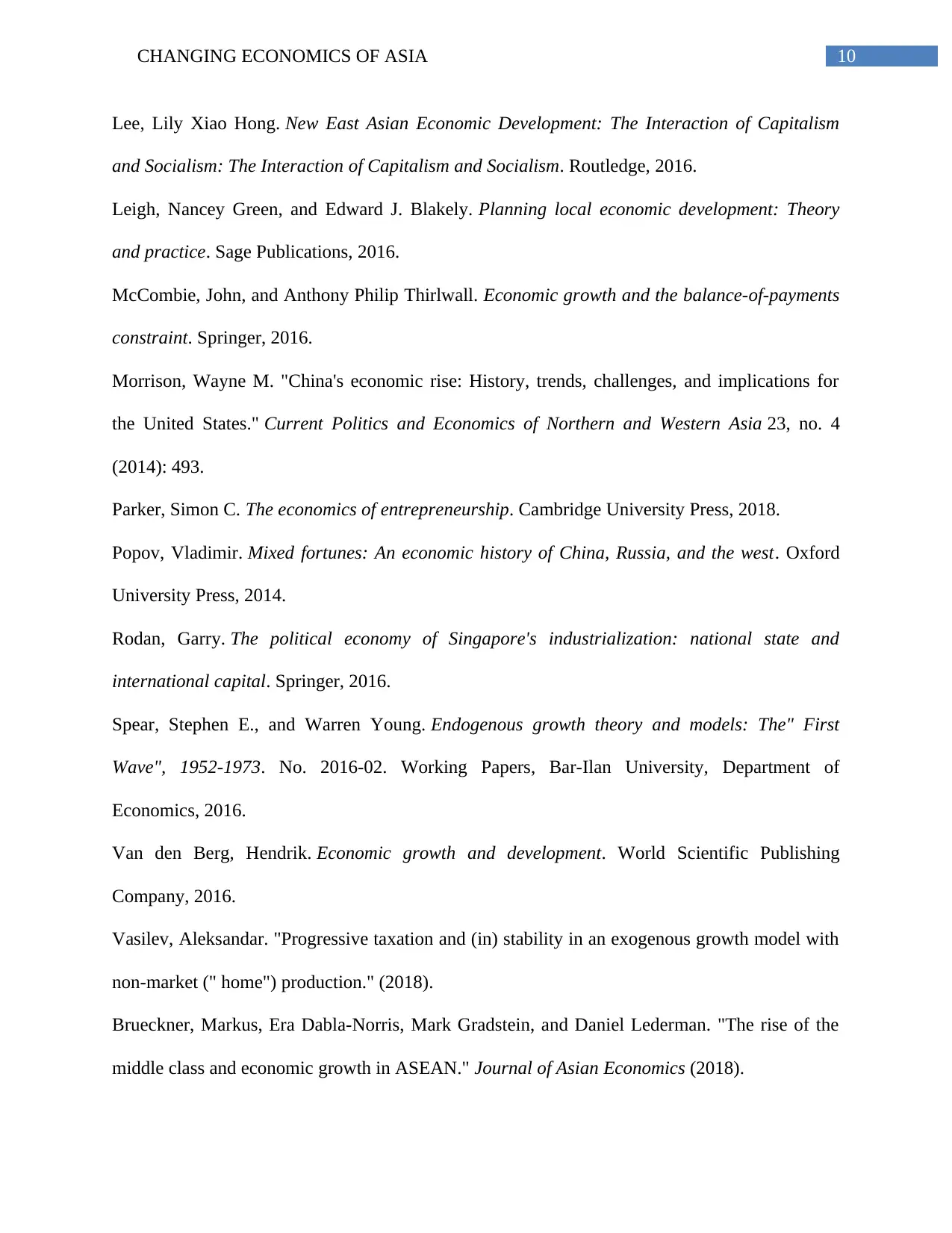
10CHANGING ECONOMICS OF ASIA
Lee, Lily Xiao Hong. New East Asian Economic Development: The Interaction of Capitalism
and Socialism: The Interaction of Capitalism and Socialism. Routledge, 2016.
Leigh, Nancey Green, and Edward J. Blakely. Planning local economic development: Theory
and practice. Sage Publications, 2016.
McCombie, John, and Anthony Philip Thirlwall. Economic growth and the balance-of-payments
constraint. Springer, 2016.
Morrison, Wayne M. "China's economic rise: History, trends, challenges, and implications for
the United States." Current Politics and Economics of Northern and Western Asia 23, no. 4
(2014): 493.
Parker, Simon C. The economics of entrepreneurship. Cambridge University Press, 2018.
Popov, Vladimir. Mixed fortunes: An economic history of China, Russia, and the west. Oxford
University Press, 2014.
Rodan, Garry. The political economy of Singapore's industrialization: national state and
international capital. Springer, 2016.
Spear, Stephen E., and Warren Young. Endogenous growth theory and models: The" First
Wave", 1952-1973. No. 2016-02. Working Papers, Bar-Ilan University, Department of
Economics, 2016.
Van den Berg, Hendrik. Economic growth and development. World Scientific Publishing
Company, 2016.
Vasilev, Aleksandar. "Progressive taxation and (in) stability in an exogenous growth model with
non-market (" home") production." (2018).
Brueckner, Markus, Era Dabla-Norris, Mark Gradstein, and Daniel Lederman. "The rise of the
middle class and economic growth in ASEAN." Journal of Asian Economics (2018).
Lee, Lily Xiao Hong. New East Asian Economic Development: The Interaction of Capitalism
and Socialism: The Interaction of Capitalism and Socialism. Routledge, 2016.
Leigh, Nancey Green, and Edward J. Blakely. Planning local economic development: Theory
and practice. Sage Publications, 2016.
McCombie, John, and Anthony Philip Thirlwall. Economic growth and the balance-of-payments
constraint. Springer, 2016.
Morrison, Wayne M. "China's economic rise: History, trends, challenges, and implications for
the United States." Current Politics and Economics of Northern and Western Asia 23, no. 4
(2014): 493.
Parker, Simon C. The economics of entrepreneurship. Cambridge University Press, 2018.
Popov, Vladimir. Mixed fortunes: An economic history of China, Russia, and the west. Oxford
University Press, 2014.
Rodan, Garry. The political economy of Singapore's industrialization: national state and
international capital. Springer, 2016.
Spear, Stephen E., and Warren Young. Endogenous growth theory and models: The" First
Wave", 1952-1973. No. 2016-02. Working Papers, Bar-Ilan University, Department of
Economics, 2016.
Van den Berg, Hendrik. Economic growth and development. World Scientific Publishing
Company, 2016.
Vasilev, Aleksandar. "Progressive taxation and (in) stability in an exogenous growth model with
non-market (" home") production." (2018).
Brueckner, Markus, Era Dabla-Norris, Mark Gradstein, and Daniel Lederman. "The rise of the
middle class and economic growth in ASEAN." Journal of Asian Economics (2018).
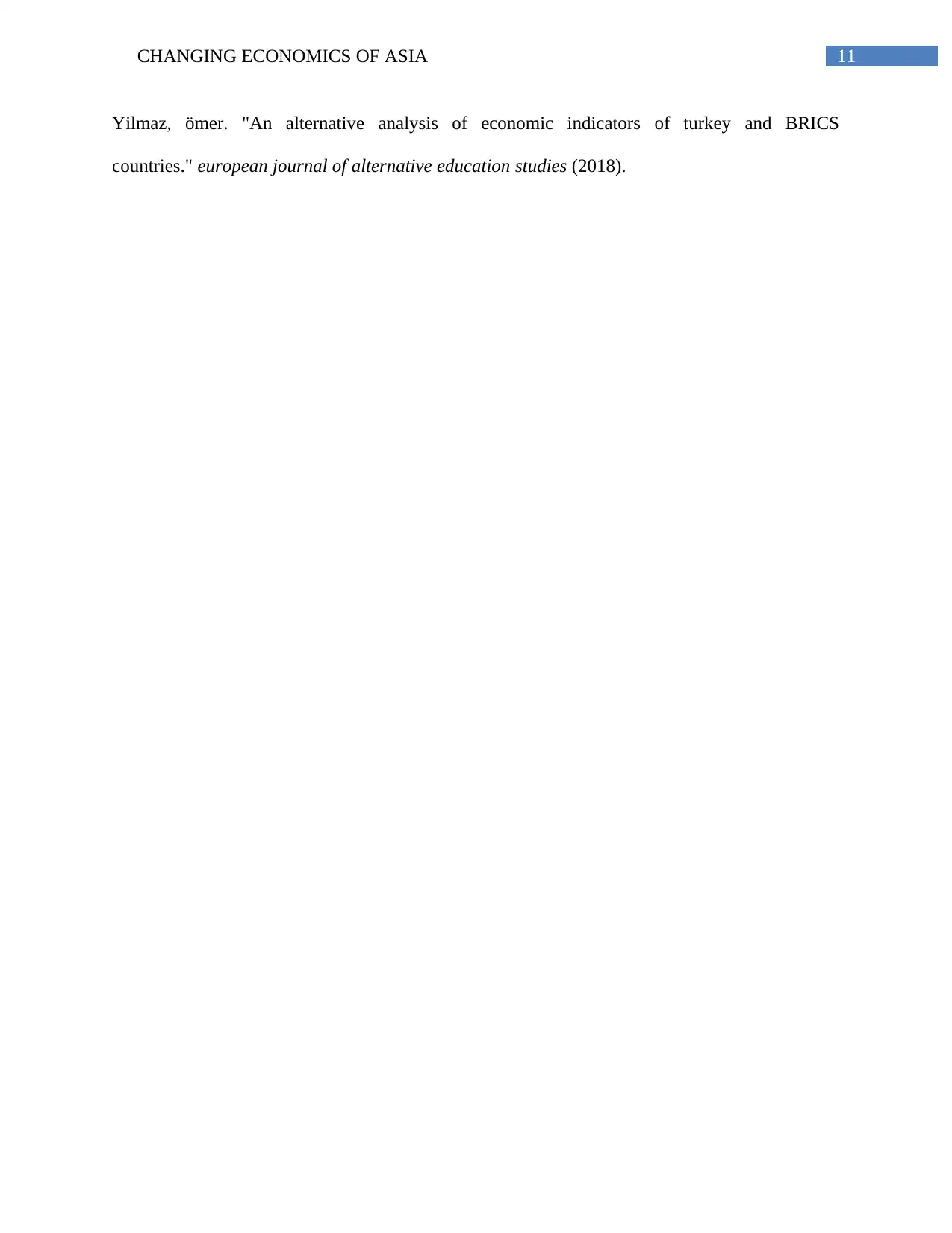
11CHANGING ECONOMICS OF ASIA
Yilmaz, ömer. "An alternative analysis of economic indicators of turkey and BRICS
countries." european journal of alternative education studies (2018).
Yilmaz, ömer. "An alternative analysis of economic indicators of turkey and BRICS
countries." european journal of alternative education studies (2018).
⊘ This is a preview!⊘
Do you want full access?
Subscribe today to unlock all pages.

Trusted by 1+ million students worldwide
1 out of 12
Related Documents
Your All-in-One AI-Powered Toolkit for Academic Success.
+13062052269
info@desklib.com
Available 24*7 on WhatsApp / Email
![[object Object]](/_next/static/media/star-bottom.7253800d.svg)
Unlock your academic potential
Copyright © 2020–2025 A2Z Services. All Rights Reserved. Developed and managed by ZUCOL.




